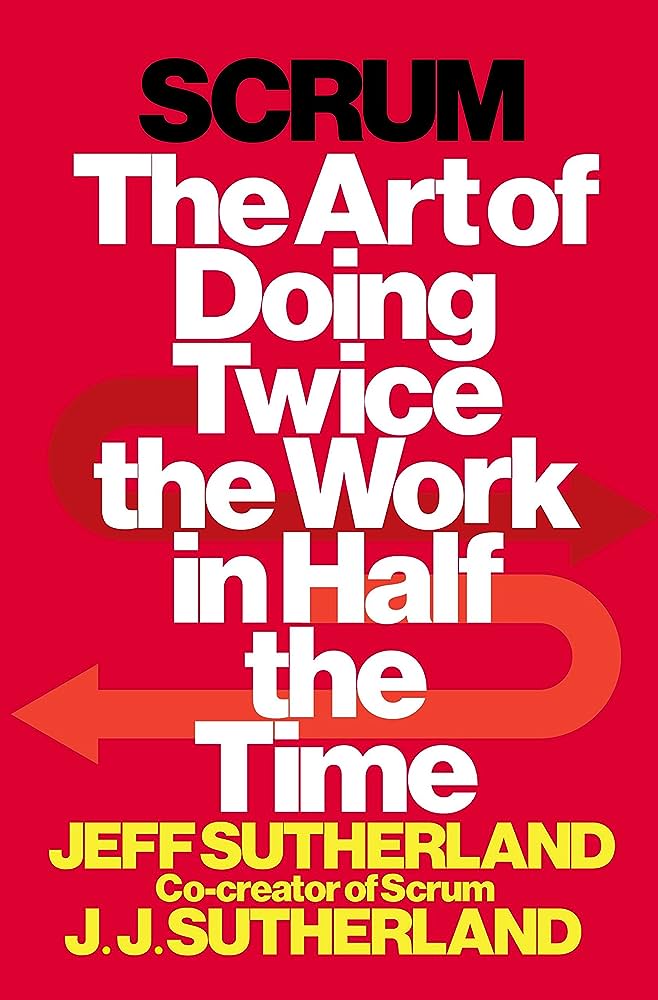
1 Line Summary
“The Art of Doing Twice the Work in Half the Time” is a book written by Jeff Sutherland, which provides an overview of the Scrum framework for Agile software development and how to use it to increase productivity and efficiency.
What Will You Learn
Here are some of the benefits of using Scrum Approach:
- Increased productivity: Scrum can help teams to deliver more work in less time.
- Improved quality: Scrum can help teams to produce higher-quality products.
- Reduced risk: Scrum can help teams to reduce the risk of delivering late or defective products.
- Increased customer satisfaction: Scrum can help teams to deliver products that meet the needs of their customers.
- Improved team morale: Scrum can help teams to be more productive and to enjoy their work more.
Best Quotations from the Book
- “The fundamental unit of Scrum is a small team of people who work together to deliver value to their customers.”
- “Scrum is based on the idea of iterative and incremental development, which means that products are developed in small increments that are delivered frequently.”
- “The Scrum framework is lightweight and easy to understand, but it can be difficult to master.”
- “Scrum is not a silver bullet, but it is a proven way to improve the productivity, quality, and customer satisfaction of software development teams.”
- “Scrum is about empowering teams, not about controlling them.”
- “Scrum is about learning and adapting, not about doing things the same way over and over again.”
- “The best way to learn about Scrum is to try it.”
Book Summary
The book is divided into three parts:
- Part I: The Basics of Scrum This part introduces the Scrum framework and its basic principles.
- Part II: Applying Scrum This part discusses how to apply Scrum to different types of projects.
- Part III: Advanced Scrum This part discusses more advanced topics related to Scrum, such as scaling Scrum and using Scrum for continuous improvement
Scrum Framework
In five succinct points, we outline the key principles of Scrum.
Agile Philosophy and Iterative Progress
- Scrum embodies the Agile philosophy, emphasizing flexibility, adaptability, and continuous improvement. Teams work in short, time-boxed cycles known as “sprints,” typically lasting two to four weeks.
- These iterations encourage regular assessment, feedback, and adjustment, ensuring projects remain aligned with goals while fostering a culture of innovation.
Empowered Cross-Functional Teams
- Scrum redefines collaboration by organizing teams around a common goal, rather than individual tasks.
- Cross-functional teams, comprised of members with diverse skills, collectively take ownership of tasks.
- Empowered to self-organize and make decisions, these teams capitalize on their expertise to optimize efficiency and quality.
Clear Roles and Responsibilities
- The Scrum framework defines distinct roles that contribute to project success.
- The Product Owner represents stakeholders, defines priorities, and ensures the product backlog—a dynamic list of work items—is refined and aligned.
- The Scrum Master facilitates the Scrum process, removing impediments and fostering team growth. Team members collaborate to deliver incremental value, focusing on completing items within the sprint.
Dynamic Backlog and Continuous Improvement
- The product backlog, a living document, encapsulates all tasks and features required for the project.
- Prioritization and refinement ensure the most valuable work is pursued.
- During sprint planning, the team selects items from the backlog for the upcoming sprint. Daily stand-up meetings promote transparency, addressing progress, challenges, and coordination.
- At the sprint review, stakeholders assess the work completed, providing feedback for refinement and future iterations.
Retrospective and Kaizen Philosophy
- Scrum’s commitment to continuous improvement is epitomized in the sprint retrospective. Teams reflect on their processes, identify areas for enhancement, and adapt their practices accordingly.
- This “kaizen” philosophy drives incremental evolution, fostering a culture of learning and innovation.
- By regularly assessing and fine-tuning their approach, teams optimize efficiency and drive sustainable growth.
Kaizen Philosophy
Key principles of the kaizen philosophy include:
- Incremental Changes: Kaizen focuses on making small, manageable changes rather than large, disruptive ones. These gradual improvements are easier to implement, assess, and adapt.
- Employee Involvement: Kaizen encourages and empowers employees at all levels to contribute ideas and suggestions for improvement. It recognizes that those closest to the work often have valuable insights into how processes can be optimized.
- Continuous Learning: Kaizen fosters a culture of learning and growth. It encourages individuals and teams to regularly reflect on their work, identify areas for improvement, and seek opportunities to enhance their skills and knowledge.
- Problem-Solving: Kaizen involves a systematic approach to problem-solving. It encourages identifying the root causes of issues, rather than simply addressing symptoms, to prevent problems from recurring.
- Standardization: While kaizen encourages continuous change, it also promotes standardizing successful improvements once they have been identified. This helps maintain consistency and sustainability in processes.
- Waste Reduction: Kaizen aims to eliminate waste in all its forms, including time, resources, and materials. By streamlining processes and minimizing inefficiencies, organizations can become more productive and cost-effective.
- Bottom-Up Approach: Kaizen encourages improvements to come from all levels of the organization, rather than being dictated solely by top management. This promotes a sense of ownership and responsibility among employees.
- Long-Term Perspective: Kaizen is not about quick fixes; it’s a long-term philosophy that emphasizes continuous, sustained improvement over time. It requires dedication and commitment from all members of the organization.
Applying Scrum
Educate and Align the Team
- Begin by immersing your team in the principles of Scrum as outlined by Sutherland. Hold an introductory session to explain the core concepts, benefits, and expectations of Scrum.
- Emphasize the significance of Agile values, iterative progress, and self-organization.
- Establish a common understanding of roles, responsibilities, and the product backlog to ensure everyone is aligned with the Scrum methodology.
Assemble Cross-Functional Teams
- Following Sutherland’s guidance, form cross-functional teams composed of members with diverse skills. These teams should possess the necessary expertise to complete end-to-end tasks.
- Designate a Product Owner to represent stakeholders, prioritize the backlog, and guide decision-making.
- Appoint a skilled Scrum Master to facilitate the Scrum process, removing obstacles, and promoting continuous improvement.
Craft a Dynamic Backlog
- Create a product backlog—a comprehensive list of features, tasks, and enhancements required for the project.
- Collaborate with stakeholders to define, prioritize, and refine backlog items.
- Use Sutherland’s principles to ensure that the most valuable and feasible work is consistently prioritized and available for selection in sprint planning.
Implement Iterative Sprints
- Embrace the heart of the Scrum framework by adopting iterative sprints.
- Set a consistent sprint duration, typically ranging from two to four weeks. During sprint planning, teams select backlog items based on priority and capacity, committing to their completion within the sprint timeframe.
- Regularly conduct daily stand-up meetings to monitor progress, address impediments, and promote collaboration.
Cultivate Continuous Improvement
- Infuse the essence of Sutherland’s “kaizen” philosophy by prioritizing continuous improvement. Conduct sprint retrospectives at the end of each iteration to reflect on team dynamics, processes, and outcomes.
- Encourage open dialogue to identify strengths, areas for enhancement, and actionable improvements.
- Apply Sutherland’s insights to refine practices, streamline workflows, and enhance team effectiveness based on retrospective findings.
How to Use Scrum for Continuous Improvement
Here’s a specific approach inspired by the book to leverage Scrum principles for ongoing enhancement:
Establish a Culture of Transparency
- Create an environment where all team members openly share progress, challenges, and insights during daily stand-up meetings.
- Transparency enables the identification of bottlenecks, impediments, and areas for improvement.
- Foster a safe space for open communication to promote proactive problem-solving.
Regular Sprint Retrospectives
At the end of each sprint, conduct a retrospective meeting where the team reflects on recent successes and challenges. Encourage open discussions about what worked well and areas that require refinement.
Kaizen Mindset in Backlog Refinement
- Apply Sutherland’s “Kaizen” philosophy to backlog refinement. Engage stakeholders and team members in continuous conversations to evolve the product backlog.
- Regularly revisit and reassess backlog items to ensure they align with changing priorities and market dynamics.
Experimentation and Adaptive Planning
- Encourage teams to incorporate experiments and innovative approaches during sprints.
- Apply the Scrum framework’s flexibility to adjust plans and strategies based on real-time feedback and insights. Sutherland’s principles guide teams to remain adaptable and willing to iterate on their processes and solutions.
Quantify and Measure Progress
- Define key performance indicators (KPIs) aligned with project goals and organizational objectives. Regularly track and measure these metrics throughout the sprint cycles.
- Sutherland’s insights encourage data-driven decision-making, enabling teams to make informed adjustments for continuous improvement.
Leverage Cross-Functional Expertise
- Align with Sutherland’s recommendations on cross-functional teams. Encourage diverse perspectives and skills within the team to drive continuous improvement.
- Sutherland’s principles advocate for leveraging the collective expertise of team members to identify and implement innovative solutions to challenges.
By integrating these insights from “Scrum: The Art of Doing Twice the Work in Half the Time,” organizations can effectively employ Scrum for continuous improvement.
If you want to deliver more value to your customers faster, then you need to learn about Scrum.
Click to read “13 Things Mentally Strong People Don’t Do“, “Code of the Extraordinary Mind”, “Emotional Intelligence and its Role in Self Awareness“ and “Solving the Procrastination Puzzle“


Pingback: Book Summary: “The Power of Positive Relationships: How to Make Them Work for You” by Karen Reivich, Andrew Shatté
Pingback: “Tools of Titans” by Tim Ferriss -
Pingback: "Drive: What Motivates Us" by Daniel H. Pink: Book Summary
Pingback: “Code of the Extraordinary Mind”: Book Summary -
Pingback: “Extreme Ownership” by Jocko Willink: Book Summary -
Pingback: "Drive: What Motivates Us" by Daniel H. Pink: Book Summary
Pingback: “Code of the Extraordinary Mind”: Book Summary »